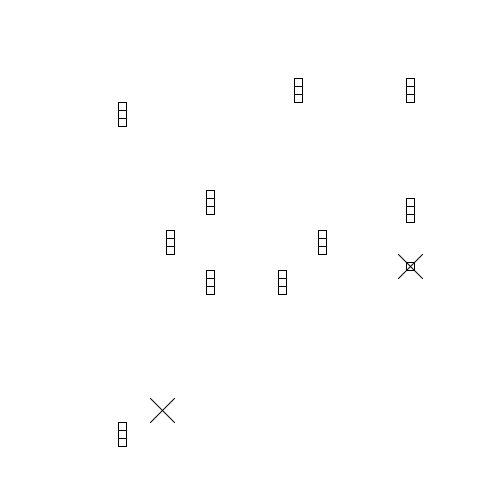Let's review again the transformation steps in one animation, and see, what conclusions we can draw about the encoding method and the solution process:
Note: with the help of the PalenqueAnimation (Java) application you can play over the entire process interactively from any angle in 3D, at different speeds and with the grid switched on/off at will.
First of all, let's do some analysis concerning the role of the various items during the transformation. From the 12 items of the initial layout, only 4 were needed to form the final figure: 2 triplets (#7, #9), the Sun (#11) and the other star (#12). The inner five items (#1–5) played their parts in constructing the inner shapes, while the three remaining triplets (#6, #8, #10) constituted the corner elements. During the first half of the process (until the control phase) the initial square number of 30 (from the 10 triplets) increased to 192 (because of the duplications and rotations), and then it declined to 37 after the second fold, and to 7 in the final figure. There were no overlaps observable between a star symbol and a triplet (which is, by the way, not at all self-evident, lots of initial layouts do produce such covers), the Sun came into connection exclusively with itself, while the other star symbol changed only its position (apart from the closing move at the end).
Note: in the appendix each state and transformation of the process is shown and analyzed separately, and for each state a description file (including the exact coordinates of all elements) can be downloaded.
One might ask, what purpose it had to conceal the (on its own fairly plain) final figure behind such a complicated transformation process, and whether it would have not been much simpler to carve it directly on the lid. Of course, the figure itself could have been engraved right on the surface without any further hassle, but, obviously, that would have made it much more difficult to interpret it as a message from another civilization, since in that case we would have had no real proof of any high-level intelligence behind the design. (In fact, even with such a sophisticated encoding in place, it will be hardly a walkover to convince the "established" science about the propriety of the interpretation.) The creators of the code certainly wanted to show all their knowledge and intelligence through it, and without doubt they had the aim to make it as complex as only possible.
And this leads us to the topic regarding the type and quality of the encoding method. At first (and maybe even at second) glance the method might seem to be a bit "childish", using forms and shapes to overlap each other, and so on. But this should not mislead us into underestimating its value or quality at all! Although perhaps a bit strange to our Western way of thinking, in itself this technique should absolutely be considered as a sophisticated and logical procedure to encode such a message, and I personally am fairly certain, that, given the final figure, even we, present day humans would hardly manage to compose a similar initial item layout, that would be able to guide its observers through several steps with an almost unmistakable logic to the expected result! Only to get a pattern like that in the control phase as a result from an arrangement requires a very careful design, not to mention the possibility of subjecting it to various transformations afterwards.
Let's also recognize that actually two different coding methods were involved in the solution, which are almost completely independent from each other: one for the story of the interstellar travel and identifying the starting solar system with the help of the final figure, and another method for getting from a given initial item arrangement to a resulting picture by executing those transformations one after the other, which the arrangement in its various phases indicates us to perform. Even if we do not accept the interpretation of the face-like shapes as representations of some solar systems, and even if we do not like the explanation about the features of the final figure, the transformation process from the original layout on the lid to the final state does stand on its own, and it clearly deserves our attention in itself. And even if the "established" science has its difficulties (quite rightly) with the topic of interstellar travels in ancient times, it should deal in my opinion at least with the second (the geometrical) method thoroughly, by clarifying its theoretical background, determining the difficulties around it, and finding algorithms for creating similar transformation processes.
Finally, perhaps a few words about the solution itself. At the risk of sounding immodest, I do really feel that it could have the potential to take the discussion about aliens in the history of the mankind and about the origin of our civilization to a new level, and to open a new chapter in the debate. It appears to be (at least to me) much more scientifically justifiable, than the previous hypotheses on this field (e.g. those of Däniken or others, which, by the way, might have caused more harm than good), and, hopefully, this time it will not be as easy for the science to prove the theory to be completely wrong, as it was the case earlier.
With that, we have reached the end of solving the Palenque code in 12 steps, and I hope, it was as fun reading it and following the steps, as it was writing these pages and creating the animations.
You may now want to go back to the front page and explore the other contents in the document, or go directly to the next page by clicking the link below.
